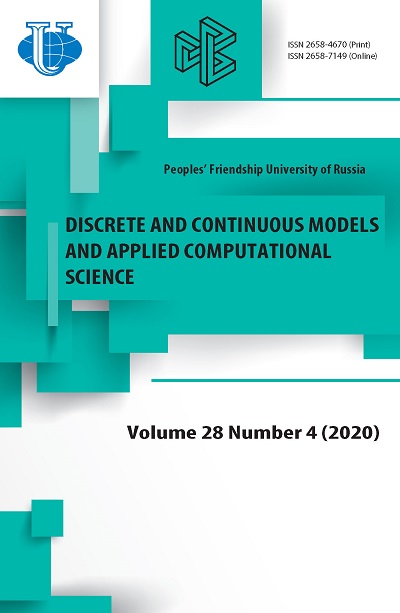On methods of quantitative analysis of the company’s financial indicators under conditions of high risk of investments
- Authors: Shchetinin E.Y.1
-
Affiliations:
- Financial University under the Government of Russian Federation
- Issue: Vol 28, No 4 (2020)
- Pages: 346-360
- Section: Articles
- URL: https://journals.rudn.ru/miph/article/view/25181
- DOI: https://doi.org/10.22363/2658-4670-2020-28-4-346-360
Cite item
Full Text
Abstract
The paper investigates the methods of quantitative analysis of hidden statistical relationships of the financial indicators of companies under conditions of high investment risk. A new semi-parametric method for estimating tail dependence indicators using BB1 and BB7 dependence structures is proposed. For a dataset containing the cost indicators of leading Russian companies, computer experiments were carried out, as a result of which it was shown that the proposed method has a higher stability and accuracy in comparison with other considered methods. Practical application of the proposed risk management method would allow financial companies to assess investment risks adequately in the face of extreme events.
Full Text
1. Introduction The global changes currently taking place in the world financial markets caused by the global pandemic of the coronavirus COVID-19, along with a catastrophic decline in oil prices, will obviously entail the need for serious changes in the business structure of both individual companies and entire industries, regional economies and countries. In the Russian conditions of high volatility of financial markets, a successful solution to this problem is impossible without the application of an analysis of the company’s resistance to the effects of the external environment, the implementation of constant monitoring of the behavior of a number of indicators of the enterprise profitability. In particular, trigger analysis [1] is one of such effective methods of analysis. The use of trigger analysis to study the sensitivity of a business structure to the impact of disturbing factors is important, since it allows identifying in advance its most weakly protected, most risky business lines, the socalled trigger points. Examples of these are individual lines of business of a company, credit and debt obligations, etc., precisely those areas of activity that potentially pose a threat of an emergency in the company. Therefore, in order to weaken © Shchetinin E. Yu., 2020 This work is licensed under a Creative Commons Attribution 4.0 International License http://creativecommons.org/licenses/by/4.0/ their influence on the structure as a whole, and on its individual lines, we proposed instead of the trigger point in its vicinity on the scatter diagram to form an aggregate set with the statistical properties of the meta-elliptic type dependence structure [2]. This allows weakening to certain limits the impact of the statistical dependence of the rest of the business lines on the problematic one and redistributing the aggregate damage to the rest of the business structure lines. In addition, the transition from an extreme dependence to a meta-elliptic one simplifies the calculation of structural risk indicators by the usual summation of the marginal risks for this structure. Examples of such an approach to managing extreme risks are debt-restructuring, transfer of fixed assets to subsidiaries and offshore companies, insurance, hedging (issuance of credit derivatives), limiting and securitization operations in the banking sector, etc. This paper considers effective methods for analyzing the financial performance of companies in the face of increased volatility in stock markets associated with the global COVID-19 pandemic, as well as declining oil prices. Using the example of analyzing the value of shares of leading Russian companies, the advantages of their application are shown in comparison with the classical multivariate analysis using a Gaussian distribution. 2. Methods for the quantitative analysis of structure indicators of statistical dependences Let (
About the authors
Eugeny Yu. Shchetinin
Financial University under the Government of Russian Federation
Author for correspondence.
Email: riviera-molto@mail.ru
Doctor of Physical and Mathematical Sciences, lecturer of Department of Data Analysis, Decision Making and Financial Technologies
49, Leningradsky Prospect, Moscow 125993, Russian FederationReferences
- E. Y. Shchetinin, “On new approaches to company management in emergency situations [Novyh podhodah k upravleniyu kompaniej v chrezvychajnyh situaciyah],” Finansy i kredit, vol. 30, no. 198, pp. 71-75, 2005, In Russian.
- E. Y. Shchetinin, K. M. Nazarenko, and A. V. Paramonov, “Instrumental methods of stochastic analysis of extreme events [Instrumental’nye metody stohasticheskogo analiza ekstremal’nyh sobytij],” Vestnik NNGU, Matematicheskoye modelirovaniye i optimal’noye upravleniye, vol. 2, no. 29, pp. 56-63, 2004, In Russian.
- V. A. Akimov, A. A. Bykov, and E. Y. Shchetinin, Introduction to statistics of extreme values, EMERCOM of Russia [Vvedenie v statistiku ekstremal’nyh znachenij i ee prilozheniya]. Moscow: FGU VNII GOChS (FTs), 2009, 524 pp., In Russian.
- R. Schmidt and U. Stadtmüller, “Non-parametric estimation of tail dependence,” Scandinavian Journal of Statistics, vol. 33, no. 2, pp. 307-335, 2006.
- R. Schmidt, Tail dependence. In Statistical tools in finance and insurance, W. Hardle, P. Cizek, and R. Weron, Eds. Springer Verlag, 2003.
- G. Frahm, M. Junker, and A. Szimayer, “Elliptical copulas: Applicability and limitations,” Statistics & Probability Letters, vol. 63, no. 3, pp. 275-286, 2003. doi: 10.1016/S0167-7152(03)00092-0.
- S. Resnick, Extreme values, regular variation and point processes. Berlin: Springer, 1987.
- E. Y. Shchetinin, “Vine copulas structures modeling on Russian stock market,” Discrete and Continuous Models and Applied Computational Science, vol. 27, no. 4, pp. 343-354, 2019. doi: 10.22363/2658-4670- 2019-27-4-343-354.
- E. Y. Shchetinin, “Modeling of D-branching structures in the Russian stock market [Modelirovanie struktur D-vetvlenij na rossijskom fondovom rynke],” Vestnik komp’yuternykh i informatsionnykh tekhnologiy, vol. 8, no. 182, pp. 38-45, 2019, In Russian.
- C. Genest, K. Ghoudi, and L. Rivest, “A semiparametric estimation procedure of dependence parameters in multivariate families of distributions,” Biometrika, vol. 82, no. 3, pp. 543-552, 1995. DOI: 10.1093/ biomet/82.3.543.
















